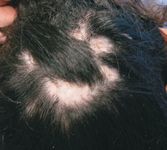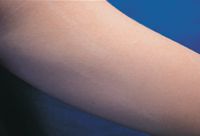- General Dermatology
- Eczema
- Chronic Hand Eczema
- Alopecia
- Aesthetics
- Vitiligo
- COVID-19
- Actinic Keratosis
- Precision Medicine and Biologics
- Rare Disease
- Wound Care
- Rosacea
- Psoriasis
- Psoriatic Arthritis
- Atopic Dermatitis
- Melasma
- NP and PA
- Skin Cancer
- Hidradenitis Suppurativa
- Drug Watch
- Pigmentary Disorders
- Acne
- Pediatric Dermatology
- Practice Management
- Prurigo Nodularis
Article
Scrutinize skin, hair, nails for genetic clues
New York - When diagnosing a pediatric hair disorder, be sure to examine not only the scalp, but also the skin, nails and even the mouth.

According to Cheryl J. Barnes, M.D., a thorough exam can prevent an underlying genetic syndrome from going undiagnosed.
"A thorough examination of the whole body, nails and teeth can give us a sign there is a syndrome that is not simply scarring alopecia," says Dr. Barnes, associate professor of medicine and pediatrics at the Medical College of Georgia in Augusta, Ga.
Specifically, she highlighted pediatric cases of incontinentia pigmenti, temporal triangular alopecia, loose anagen syndrome and trichotillomania.
"These are more common than people realize, and I wanted to bring them to the forefront," she explains. "These are good things to think about in pediatric patients."
Logical mode of classification She says a logical way of classifying pediatric alopecias is to think of them as congenital or acquired and localized or diffused.
Congenital-Localized - Two pediatric alopecias that are usually congenital and localized are incontinentia pigmenti (IP) and temporal triangular alopecia (TTA).
IP can present as patches of non-progressive scarring alopecia on the vertex scalp that may have initially been erythematous and crusted. A thorough examination of the skin can reveal any of the cutaneous stages of IP such as hypopigmented or hyperpigmented linear streaks that distinguish it from other alopecias. The child may have peg-shaped teeth, nail dystrophy, seizures and mental retardation.
Because it is an X-linked dominant disease, Dr. Barnes recommends examining the child's parents.
If this diagnosis is missed, serious sequelae can result, such as retinal complications. IP affects neuroectoderm tissues and organs.
Temporal triangular alopecia is a benign, non-scarring, non-progressive alopecia that is typically noticed around age two or three. Most (80 percent) cases are unilateral, 20 percent are bilateral frontotemporal. Despite the condition's name, the affected area can be shaped like a lancet or circle, as well as a triangle.
"Alopecia areata can mimic this, but usually it is not just in the temporal region," she notes. "Look at the distribution. When in doubt, biopsy to confirm, instead of giving harmful therapies that are not needed or helpful."
This condition does not respond to topical steroids, which are potentially harmful to a patient. Treatment options include surgical corrections with hair grafts or excisional removal.

It can be associated with other abnormalities, such as Noonan's syndrome, nail patella syndrome, tricho-rhino phalangeal syndrome, hypohidrotic ectodermal dysplasia and others.
"Years ago, it was thought that it (loose anagen syndrome) did not go along with other syndromes, but it does," Dr. Barnes notes.
To diagnose, check for a painless hair pull in which hair slides out easily, examine the parents' hair, assess if the child looks younger than his or her chronological age. Dr. Barnes recommends a light microscopy exam, which would reveal absent inner root sheaths, ruffled cuticles and misshapen bulbs of anagen hair. A scalp biopsy is not helpful.






